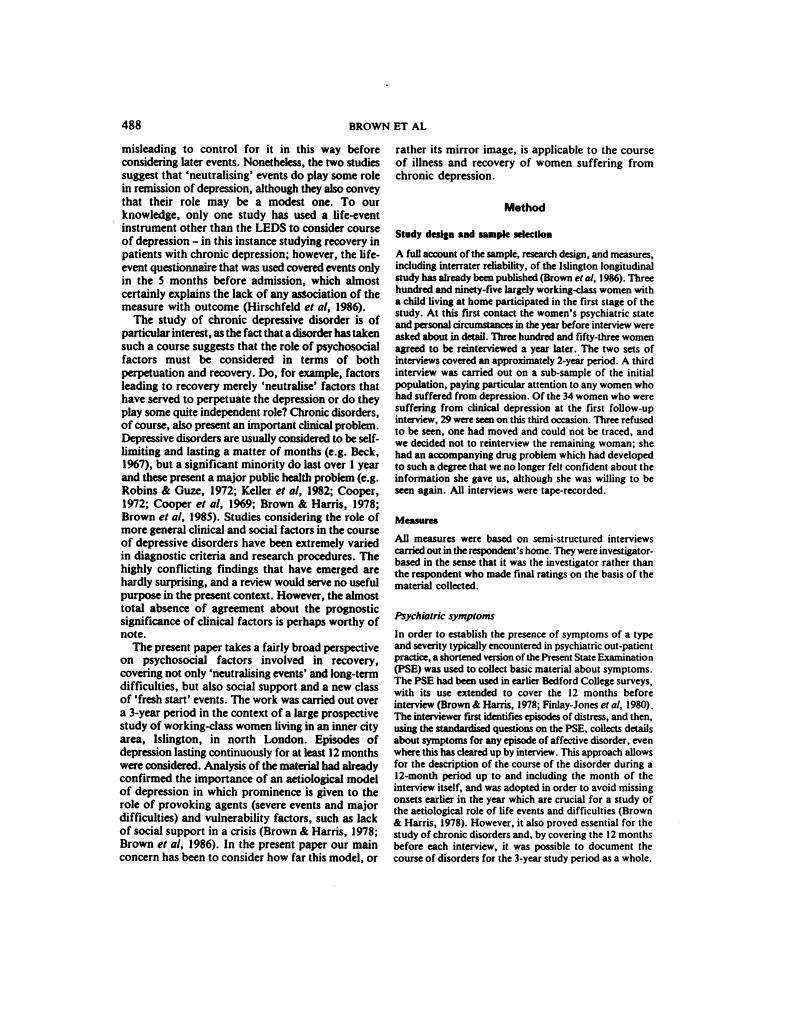Crossref Citations
This article has been cited by the following publications. This list is generated based on data provided by Crossref.
Katschnig, H.
and
Nutzinger, D. O.
1988.
Depressive Illness.
p.
63.
Brown, G. W.
Bifulco, A.
and
Andrews, B.
1990.
Self-esteem and depression.
Social Psychiatry and Psychiatric Epidemiology,
Vol. 25,
Issue. 5,
p.
244.
Paykel, E. S.
1990.
Affective and Schizoaffective Disorders.
p.
107.
Brown, G. W.
Andrews, B.
Bifulco, A.
and
Veiel, H.
1990.
Self-esteem and depression.
Social Psychiatry and Psychiatric Epidemiology,
Vol. 25,
Issue. 4,
p.
200.
Beckham, E.Edward
1990.
Psychotherapy of depression research at a crossroads: Directions for the 1990s.
Clinical Psychology Review,
Vol. 10,
Issue. 2,
p.
207.
Miller, P. McC
and
Lloyd, C.
1991.
Social support and its interactions with personality and childhood background as predictors of psychiatric symptoms in Scottish and American medical students.
Social Psychiatry and Psychiatric Epidemiology,
Vol. 26,
Issue. 4,
p.
171.
Zimmer, Friederike T.
1991.
Depressionskonzepte heute: Psychopathologie oder Pathopsychologie?.
p.
249.
Oatley, Keith
and
Perring, Christina
1991.
A Longitudinal Study of Psychological and Social Factors Affecting Recovery from Psychiatric Breakdowns.
British Journal of Psychiatry,
Vol. 158,
Issue. 1,
p.
28.
Howland, Robert H.
and
Thase, Michael E.
1991.
Biological studies of Dysthymia.
Biological Psychiatry,
Vol. 30,
Issue. 3,
p.
283.
Birch, N.J
Srinivasan, D.P
Brugha, TraolachS
Brewin, ChrisR
Bebbington, PaulE
Checkley, Stuart
Rutz, Wolfgang
Walinder, Jan
Eberhard, Göran
Von Knorring, Anne-Liis
Von Knorring, Lars
Wistedt, Börje
and
Åberg-Wistedt, Anna
1992.
Prevention of suicide.
The Lancet,
Vol. 340,
Issue. 8829,
p.
1233.
Veiel, Hans O. F.
Kühner, Christine
Brill, Gerhard
and
Ihle, Wolfgang
1992.
Psychosocial correlates of clinical depression after psychiatric in-patient treatment: methodological issues and baseline differences between recovered and non-recovered patients.
Psychological Medicine,
Vol. 22,
Issue. 2,
p.
415.
Brown, G. W.
Lemyre, L.
and
Bifulco, A.
1992.
Social Factors and Recovery from Anxiety and Depressive Disorders.
British Journal of Psychiatry,
Vol. 161,
Issue. 1,
p.
44.
Lora, Antonio
and
Fava, Emilio
1992.
Provoking agents, vulnerability factors and depression in an Italian setting: a replication of Brown and Harris's model.
Journal of Affective Disorders,
Vol. 24,
Issue. 4,
p.
227.
GORMAN, DENNIS M.
and
BROWN, GEORGE W.
1992.
Recent developments in life‐event research and their relevance for the study of addictions.
British Journal of Addiction,
Vol. 87,
Issue. 6,
p.
837.
HAMILTON, ELIZABETH BURNEY
JONES, MAREN
and
HAMMEN, CONSTANCE
1993.
Maternal Interaction Style in Affective Disordered, Physically III, and Normal Women.
Family Process,
Vol. 32,
Issue. 3,
p.
329.
Romans, S. E.
Walton, V. A.
McNoe, B.
Herbison, G. P.
and
Mullen, P. E.
1993.
Otago Women's Health Survey 30-Month Follow-Up.
British Journal of Psychiatry,
Vol. 163,
Issue. 6,
p.
739.
Howland, Robert H.
1993.
Chronic Depression.
Psychiatric Services,
Vol. 44,
Issue. 7,
p.
633.
Miller, P. McC
and
Surtees, P. G.
1993.
Partners in adversity: II. Measurement and description of stressful event sequences (‘Complexes’).
European Archives of Psychiatry and Clinical Neuroscience,
Vol. 242,
Issue. 4,
p.
233.
Goodyer, Ian M.
1993.
Recent stressful life events: Their long term effects.
European Child & Adolescent Psychiatry,
Vol. 2,
Issue. 1,
p.
1.
Hayes, Adele M.
and
Newman, Cory F.
1993.
Comprehensive Handbook of Psychotherapy Integration.
p.
303.




eLetters
No eLetters have been published for this article.